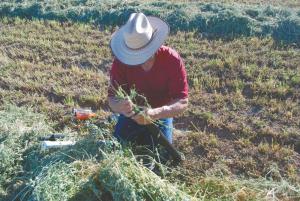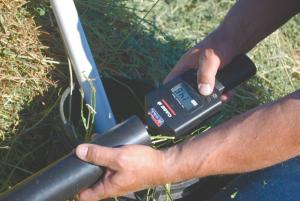Testing Windrow Moisture Content
Today many large balers have on-board moisture testing equipment and have various moisture testers or can apply preservatives to the hay to maximize leaf retention and still maintain storage quality. Despite all these tools, a producer is still faced with the dilemma of determining the stem moisture of hay in the windrow across the entire field.
The age-old method of twisting a handful of alfalfa until it breaks is a good way to know the hay is dry enough to bale, but unfortunately by the time the hay is dry enough to break by this method it’s too dry for good leaf retention. Some producers today insert an electronic moisture probe into a handful of alfalfa from the underside of sample windrows to get an idea of the moisture. While this is a step up from the twist test, the probe will tend to provide data suggesting the hay is dryer than it actually may be. Other methods use ovens to test hay, but they can be awkward and slow.
Now two University of Idaho researchers, Ron Thaemert and Glenn Shewmaker, have developed an inexpensive moisture testing tool that can be made with a few simple supplies from the local hardware store. It replicates the compaction and density of hay in a bale.
Here are the materials needed for the windrow sampling tool:
2 ft. of 2-in. ABS pipe
3 ft. of 1 1/4-in. PVC pipe
2 1 1/4-in. PVC pipe caps
2-in. ABS cleanout adapter
2-in. ABS cleanout plug
Assemble the tool by gluing the end caps on the 1 1/4-in. pipe, forming a simulated plunger. Next glue the cleanout adapter on one end of the 2-in. ABS pipe. Screw the 2-in. ABS cleanout plug into the adapter, forming a simulation of a bale chamber, and you’re ready to moisture test alfalfa in a windrow.
Thaemert and Shewmaker say you should take at least 20 random samples per 200 tons of hay across the whole field.
Once a sample location is selected, turn a portion of the windrow over and feel for the dampest hay in the sample area. Insert this hay into the sampling tool a handful at a time until the tube is full. Place the collection chamber on the ground with the capped end down and use the smaller tube, or plunger, to compress the hay in the collection chamber, simulating the compaction of baled hay.
Record electronic moisture readings from four levels of the collection chamber and average the readings at 4, 8, 12, and 16-in. depth. Continue the process across the remainder of the field and average the data from all of the samples. “You have now gathered ample moisture samples on which you can confidently base your baling readiness decision,” report Thaemert and Shewmaker.
Care should be taken to clean the electronic probe after a few samples have been collected. As residue builds up on the probe it begins to reduce the accuracy of the reading. Also, probe readings should be compared to oven samples periodically to make sure the probe is calibrated correctly.

Click here to download page story appeared in.
Click here to read entire issue
Testing Windrow Moisture Content HAY & FORAGE HARVESTING Accessories Today many large balers have on-board moisture testing equipment and have various moisture testers or can apply preservatives to the hay to maximize leaf retention and still maintain storage quality Despite all these tools a producer is still faced with the dilemma of determining the stem moisture of hay in the windrow across the entire field The age-old method of twisting a handful of alfalfa until it breaks is a good way to know the hay is dry enough to bale but unfortunately by the time the hay is dry enough to break by this method it’s too dry for good leaf retention Some producers today insert an electronic moisture probe into a handful of alfalfa from the underside of sample windrows to get an idea of the moisture While this is a step up from the twist test the probe will tend to provide data suggesting the hay is dryer than it actually may be Other methods use ovens to test hay but they can be awkward and slow Now two University of Idaho researchers Ron Thaemert and Glenn Shewmaker have developed an inexpensive moisture testing tool that can be made with a few simple supplies from the local hardware store It replicates the compaction and density of hay in a bale Here are the materials needed for the windrow sampling tool: 2 ft of 2-in ABS pipe 3 ft of 1 1/4-in PVC pipe 2 1 1/4-in PVC pipe caps 2-in ABS cleanout adapter 2-in ABS cleanout plug Assemble the tool by gluing the end caps on the 1 1/4-in pipe forming a simulated plunger Next glue the cleanout adapter on one end of the 2-in ABS pipe Screw the 2-in ABS cleanout plug into the adapter forming a simulation of a bale chamber and you’re ready to moisture test alfalfa in a windrow Thaemert and Shewmaker say you should take at least 20 random samples per 200 tons of hay across the whole field Once a sample location is selected turn a portion of the windrow over and feel for the dampest hay in the sample area Insert this hay into the sampling tool a handful at a time until the tube is full Place the collection chamber on the ground with the capped end down and use the smaller tube or plunger to compress the hay in the collection chamber simulating the compaction of baled hay Record electronic moisture readings from four levels of the collection chamber and average the readings at 4 8 12 and 16-in depth Continue the process across the remainder of the field and average the data from all of the samples “You have now gathered ample moisture samples on which you can confidently base your baling readiness decision ” report Thaemert and Shewmaker Care should be taken to clean the electronic probe after a few samples have been collected As residue builds up on the probe it begins to reduce the accuracy of the reading Also probe readings should be compared to oven samples periodically to make sure the probe is calibrated correctly
To read the rest of this story, download this issue below or click
here to register with your account number.









